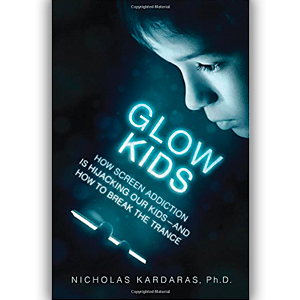
How to Stop Screen Addiction: A Review of Glow Kids
In Glow Kids by Dr. Nicholas Kardaras, he builds the persuasive case that screen addiction is hijacking our kids and that parents need to break the trance. Citing a plethora of studies correlating technology with disorders like ADHD, depression, and aggression, Kardaras establishes the profound consequences of screens on children’s brains. While the book focuses heavily on the negative impact of video games, it also offers substantial research on the damaging effects of social media and the problems with educational reforms that rely on technology.
Dr. Kardaras, an expert in addiction, explains brain imaging reveals what psychologists have long suspected – “Screen addiction looks like drug addiction in the brain.” Referencing study after study, he demonstrates how video games are essentially “digital drugs” because, like other stimulants, they increase dopamine levels in children’s brains, making it difficult for kids to say no.
Like the disturbing “Don’t text while driving” commercials airing these days, Glow Kids includes powerful anecdotes from Dr. Kardaras’s experiences with screen addicted adolescents. Kardaras quotes Dr. Gary Slutkin, who “views the spread of real-life violence as being analogous to an infectious disease – and violent video gaming as a risk factor in contracting that disease.” In chapter after chapter, Glow Kids raises more red flags than I can mention in this review, but the data on topics like mean girls and depression makes his claims difficult to dispute.
While most of the video game references involve boys, Kardaras does establish just how dangerous the “Text Effect” is, especially for girls. Kardaras writes, “Compulsive texting involves trying and failing to cut back on texting, becoming defensive when challenged about the behavior, and feeling frustrated when one can’t do it.” According to the research, today’s “hypernetworking teens were found to be 69 percent more likely to have tried sex, 60 percent more likely to report four or more sexual partners, 84 percent more likely to have used illegal drugs and 94 percent more likely to have been in a physical fight.”
Whether addressing new clinical disorders, such as Electronic Screen Syndrome or Distracted Parent Syndrome, through this book, Kardaras presents a compelling argument that screens are hurting our children on many levels. When you consider that the Kaiser Foundation reported in 2010 that kids were spending 7.5 hours a day in front of a screen, is it any wonder that more and more children struggle to attend to what some might define as blaze real life? Over the last 30 years, Kardaras reports, there has been an 800 percent increase in ADHD. 800 percent!
Ultimately, Kardaras recognizes we live in an e-world and children have to learn to get along in it. However, Kardaras explains that the part of the brain that controls impulses is “under construction” until a person’s early twenties. This is why it’s imperative that parents set limits when it comes to screens.
So if you’re interested in combating what Kardaras considers technology’s erosion of a healthy, balanced, childhood, check out Glow Kids. It’ll inspire you to refocus your kids world on what really matters: relationships with real people.
Follow @ParentbytheBook on Twitter for updates on blog posts or like Parenting by the Book on Facebook.






